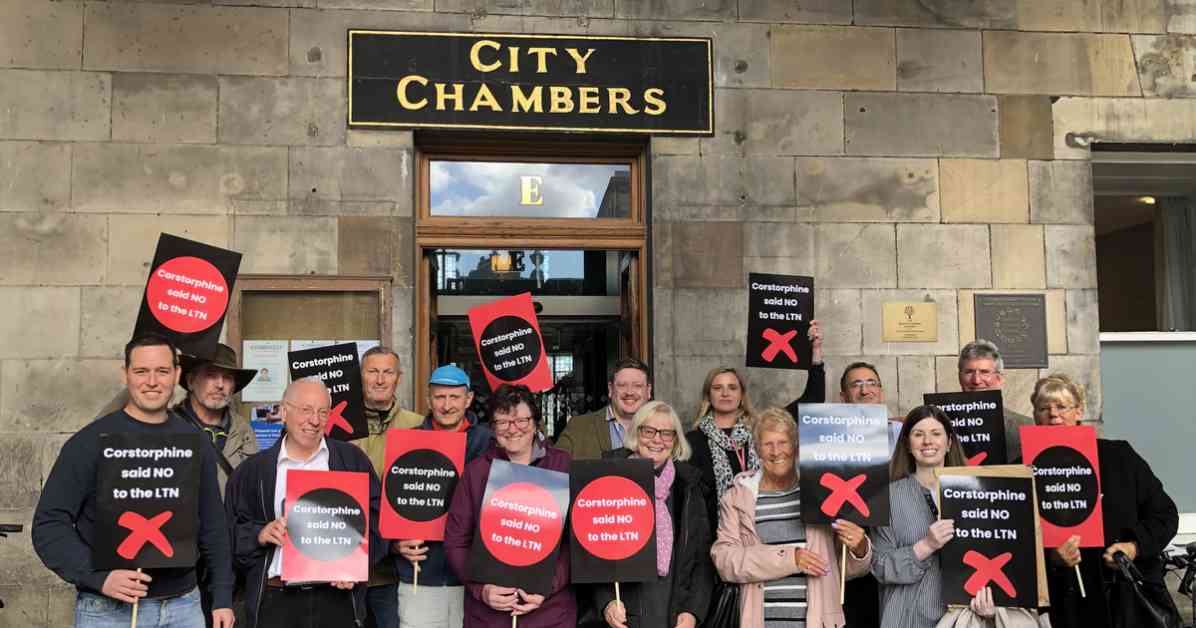Edinburgh Council is facing backlash for allegedly manipulating data to support a controversial Low Traffic Neighbourhood (LTN) scheme in Corstorphine. The council conducted a survey that suggested 50% of residents support the project, while 24% oppose it. However, critics argue that the sample used in the survey was unreliable, as it did not include feedback from all affected parties, such as housebound residents and carers. The LTN, which includes road closures and widened pavements, has divided the community and sparked anger among residents.
The Controversial Low Traffic Neighbourhood Scheme
The Low Traffic Neighbourhood (LTN) scheme in Corstorphine has been a point of contention among residents since its implementation last year. The project aims to reduce traffic on residential streets by closing off certain roads to through traffic, implementing footway and crossing improvements, and imposing traffic restrictions around primary schools during drop-off and pick-up times. While the measures have led to a 9.2% decrease in traffic around Corstorphine Primary School, there has been an overall 6.5% increase in traffic in the neighborhood, slightly above the average rise in western Edinburgh.
Local resident Peter Roberts, from the Accessible Corstorphine for Everyone (ACE) group, criticized the LTN during a transport committee meeting, stating that it has not made the area safer but rather more dangerous and less accessible. Roberts pointed out that the reduction in traffic on Manse Road due to the bus gate has been offset by increases on nearby streets. He also raised concerns about the sampling bias in the council’s survey, noting that certain groups, such as motorists, housebound residents, businesses, and carers, were not included in the data collection process.
Councilman Euan Davidson echoed these concerns, highlighting the exclusion of elderly and disabled residents from the survey. He questioned how the market research could accurately represent the views of the entire community when it only involved speaking to pedestrians on the street. Liberal Democrat group leader Kevin Lang also expressed doubts about the survey’s methodology, suggesting that it may have led to a skewed response.
In response to the criticism, project manager Martin Lings defended the survey, stating that between 70-80% of respondents were car drivers and 80-90% used public transport. He also mentioned that the interviewers spoke to individuals who identified as disabled or with serious health conditions. Despite these explanations, residents like Warwick Campbell and Kirsten Olverman have voiced their dissatisfaction with the LTN, citing longer travel times and feeling trapped in the neighborhood.
Community Support and Opposition
The Low Traffic Corstorphine group, which supports the LTN, has argued that the measures have had a positive impact on the community, creating a safer and more comfortable environment for active travel and community engagement. They urged the council to continue and expand the scheme, emphasizing its contributions to Edinburgh’s and Scotland’s sustainable transport goals. However, residents like Warwick Campbell and Kirsten Olverman have highlighted the challenges they face due to the LTN, including longer commute times and feeling restricted in their movements.
Despite the differing views on the LTN, the council’s traffic regulation orders sub-committee is set to vote on whether to make the scheme permanent. This decision will have significant implications for the residents of Corstorphine and could shape the future of traffic management in the area. As the community grapples with the impacts of the LTN, it is crucial for all voices to be heard and considered in the decision-making process.
The Impact of the LTN on Local Businesses
In addition to affecting residents, the Low Traffic Neighbourhood scheme has had a significant impact on local businesses in Corstorphine. Neilsons Solicitors and Estate Agents, which has its head office on St John’s Road, raised concerns about the LTN’s impact on travel times and accessibility for employees and clients. Kirsten Olverman from Neilsons noted that a journey that previously took 10 minutes now takes much longer due to the LTN and bus gate restrictions.
The challenges faced by businesses like Neilsons highlight the broader economic implications of the LTN on the local economy. As businesses struggle to navigate the changes brought about by the scheme, it is essential for policymakers to consider the impact on commercial activities and address any issues that may arise. Ensuring that businesses have a voice in the decision-making process is crucial for fostering a thriving and sustainable local economy in Corstorphine.
Moving Forward: Finding Common Ground
As the debate over the Low Traffic Neighbourhood scheme in Corstorphine continues, it is essential for all stakeholders to come together to find common ground and address the concerns raised by residents, businesses, and community groups. While the LTN aims to improve road safety and promote active travel, its implementation has sparked division and discontent within the community.
To move forward effectively, the council must engage in transparent and inclusive dialogue with residents and businesses to address their concerns and work towards solutions that benefit all parties. By fostering collaboration and communication, policymakers can navigate the complexities of the LTN scheme and ensure that the voices of all community members are heard and valued.
In conclusion, the controversy surrounding the Low Traffic Neighbourhood scheme in Corstorphine underscores the importance of inclusive decision-making and community engagement in urban planning initiatives. As the council considers the future of the LTN, it must prioritize the needs and concerns of residents, businesses, and community groups to create a more sustainable and equitable environment for all. By working together and finding common ground, stakeholders can build a brighter future for Corstorphine and ensure that the community thrives in the years to come.













